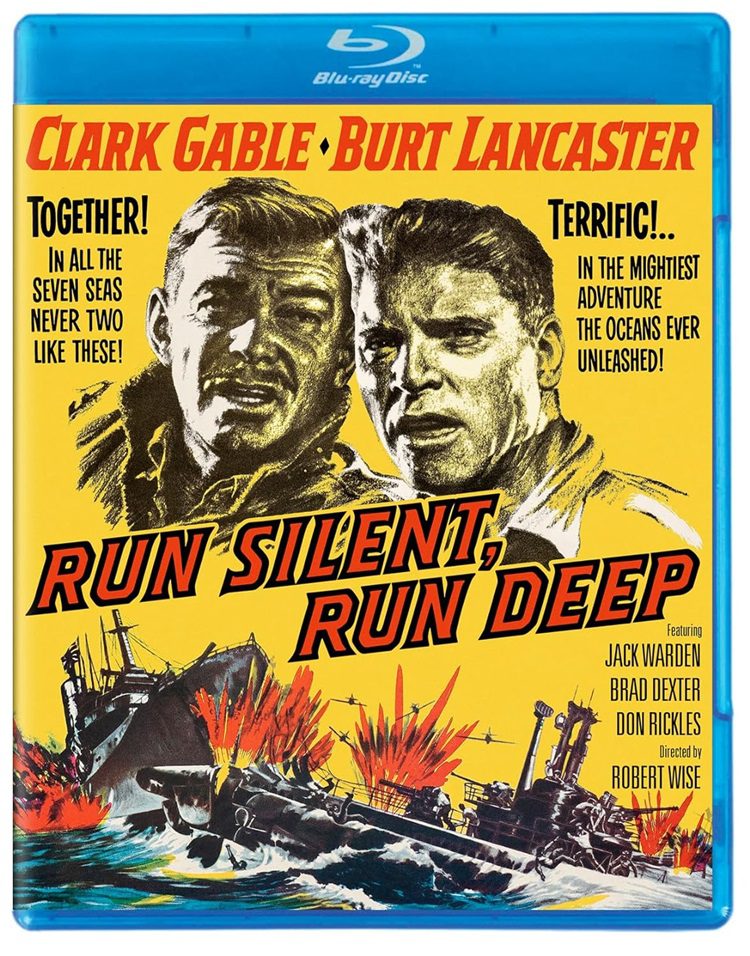
When my brother joined the Navy in the mid-1990s, he volunteered for submarine duty. It paid more than serving on a regular ship and he figured he’d spend most of his time way below deck on a boat, so why not make a few extra bucks? After watching Run Silent, Run Deep, I don’t think there is enough money in the world to make me get on a sub. I’m surprised anyone is ever willing to get inside one.
Buy Robert Wise’s Run Silent Run DeepRun Silent, Run Deep was made by Burt Lancaster’s production company. Looking for a hit after the financial failure of Sweet Smell of Success (considered a classic today, the film completely bombed at the box office in its initial run), Lancaster wanted to make something more audience-friendly. A big, tense World War II film fit the bill. Knowing his films usually did better when he had a big-named costar, he hired Clark Gable to play off of. Oscar-winner Robert Wise was hired to direct. Despite all this, the film did poorly at the box office.
It was a troubled shoot with Lancaster and Gable quarreling over the script. Gable, who was 57 at the time of filming and in ill health, demanded to go home every day at 5 pm and often walked off the set even when his scenes were not done shooting. Despite all of this, the film is now considered a minor classic and has gone on to influence just about every other submarine movie ever made.
Gable plays Commander P.J. “Rich” Richardson, who at the beginning of the film has his submarine sunk by the Japanese destroyer Akikaze in the Bungo Straights off the coast of Japan. He survives but most of his crew is lost. After pushing pencils at a desk for a year, he talks the high command into letting him captain another submarine – a submarine that was initially supposed to be helmed by Lieutenant Jim Bledsoe (Lancaster). Like the two actors fighting over the script, these two characters will spend the film butting heads over the direction of their mission.
Richardson has orders to patrol the same area around Japan but is explicitly forbidden to enter the Bungo Straits as the Navy has already lost four ships there in the last year. But Richardson has a Captain Ahab-like fixation on the Straits and his white whale is the Akikaze. After drilling his crew on a particular “diving while blasting torpedos” maneuver, they head straight for the Bungo Straits.
One particular part of the script that Gable didn’t like was how about halfway through, Richardson steps down, relinquishing control of the submarine to Bledsoe. Gable had made a career playing tough guys who didn’t back down, and he figured this would damage his reputation. A compromise was added allowing Richardson to be severely injured thus allowing him to give the reins to Bledsoe without losing face.
The film has everything you’ve come to expect from a submarine movie (and this film is mostly why you’ve come to expect those things – watch The Hunt For Red October after this film and you’ll start to think you are having flashbacks). Richardson is tough and commanding. His XO Bledsoe is constantly at odds with him, but he follows orders. The crew is ready to mutiny. The submarine battles are as tense as anything ever put on film. There are depth charges, rogue torpedoes, head-to-head battles with destroyers and other submarines, and a moment in which our heroes must remain quiet unless they are spotted and destroyed.
Robert Wise keeps things appropriately claustrophobic and tense. Some scenes were shot in and around an actual World War II-era U.S. submarine and the Navy allowed the film to borrow some $500,000 worth of equipment. The action scenes were shot with miniatures and while you can often tell they are models (and see the sides of the pool or the literal strings pulling them along) they still look amazing. I’ll take that over stodgy CGI every time.
Lancaster and Gable are great as is the supporting cast (featuring Jack Warden and Don Rickles, in his first film role). Since it was so influential, it can now feel a little old hat at times until you recognize it was the first to do what has now become a cliche in these types of films.
Extras on this Kino Lorber release include an entertaining audio commentary from filmmaker/historian Steve Mitchell and Combat Films: American Realism author Steven Jay Rubin.